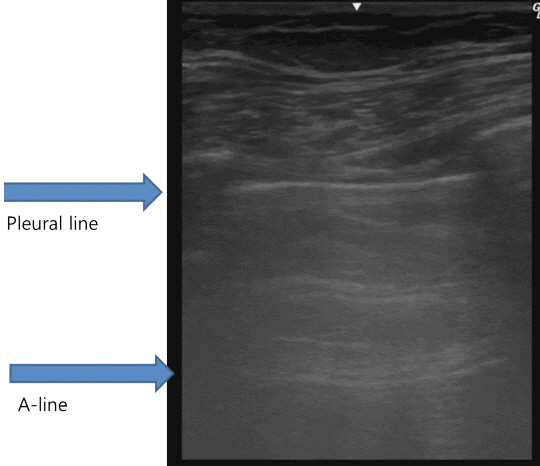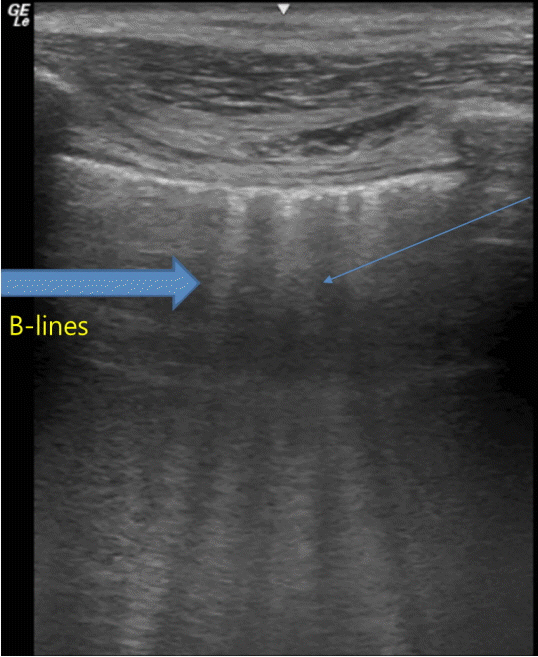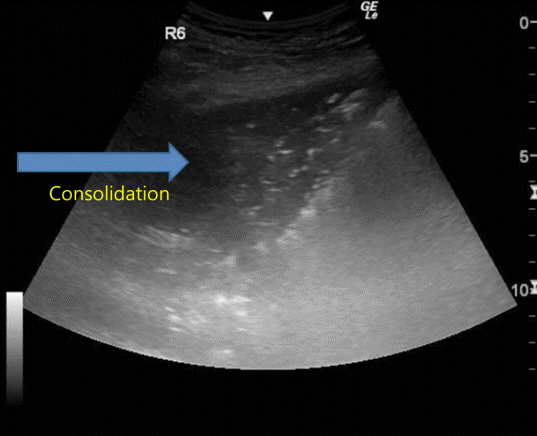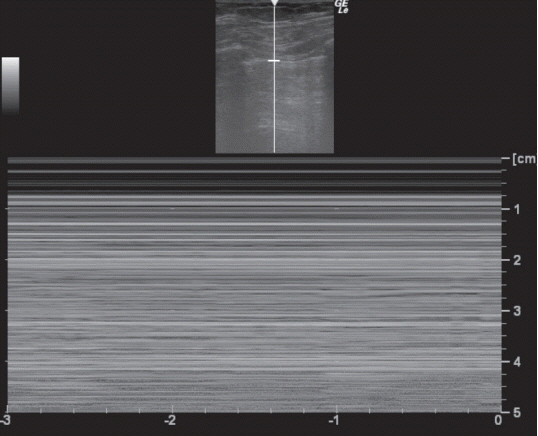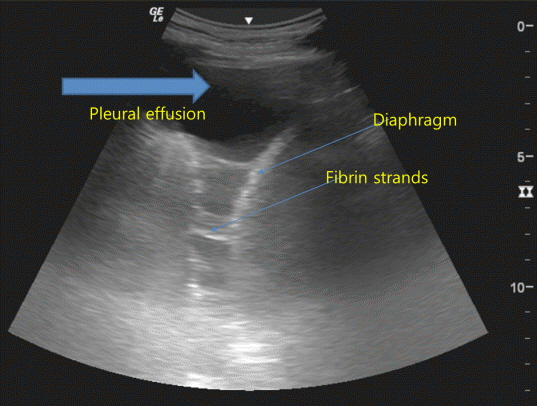Korean J Crit Care Med.
2016 Feb;31(1):4-9. 10.4266/kjccm.2016.31.1.4.
Lung Ultrasound in Critically Ill Patients
- Affiliations
-
- 1Division of Pulmonary and Critical Care Medicine, Department of Internal Medicine, Seoul National University College of Medicine, Seoul, Korea. realrain7@gmail.com
- KMID: 2227606
- DOI: http://doi.org/10.4266/kjccm.2016.31.1.4
Abstract
- Lung ultrasound (LUS) is an emerging tool for intensivists to diagnose and monitor thoracic diseases of critically ill patients. It is easily applied at the bedside in real time and is free of radiation hazards. In the intensive care units (ICUs) lung ultrasound can be used to diagnose pneumothorax and interstitial syndrome. It can also be used to monitor changes in the lung. However, the major limitations of LUS is that it is highly operator dependent and cannot be applied in patients with thoracic dressings, subcutaenous emphysema or pleural calcifications. This article reviews the basic principles of lung ultrasound and discusses how it can be used in ICUs.
Keyword
MeSH Terms
Figure
Reference
-
References
1. Warren J, Fromm RE Jr, Orr RA, Rotello LC, Horst HM; American College of Critical Care Medicine. Guidelines for the inter- and intrahospital transport of critically ill patients. Crit Care Med. 2014; 32:256–62.
Article2. Mayo JR, Aldrich J, Muller NL; Fleischner Society. Radiation exposure at chest CT: a statement of the Fleischner Society. Radiology. 2003; 228:15–21.
Article3. Volpicelli G, Elbarbary M, Blaivas M, Lichtenstein DA, Mathis G, Kirkpatrick AW, et al. International evidence-based recommendations for point-of-care lung ultrasound. Intensive Care Med. 2012; 38:577–91.
Article4. Volpicelli G, Mussa A, Garofalo G, Cardinale L, Casoli G, Perotto F, et al. Bedside lung ultrasound in the assessment of alveolar-interstitial syndrome. Am J Emerg Med. 2006; 24:689–96.
Article5. Lichtenstein DA, Mezière GA. Relevance of lung ultrasound in the diagnosis of acute respiratory failure: the BLUE protocol. Chest. 2008; 134:117–25.
Article6. Bouhemad B, Zhang M, Lu Q, Rouby JJ. Clinical review: bedside lung ultrasound in critical care practice. Crit Care. 2007; 11:205.7. Via G, Storti E, Gulati G, Neri L, Mojoli F, Braschi A. Lung ultrasound in the ICU: from diagnostic instrument to respiratory monitoring tool. Minerva Anestesiol. 2012; 78:1282–96.8. Baldi G, Gargani L, Abramo A, D’Errico L, Caramella D, Picano E, et al. Lung water assessment by lung ultrasonography in intensive care: a pilot study. Intensive Care Med. 2013; 39:74–84.
Article9. Via G, Lichtenstein D, Mojoli F, Rodi G, Neri L, Storti E, et al. Whole lung lavage: a unique model for ultrasound assessment of lung aeration changes. Intensive Care Med. 2010; 36:999–1007.
Article10. Lichtenstein D, Mézière G, Biderman P, Gepner A, Barré O. The comet-tail artifact. An ultrasound sign of alveolar-interstitial syndrome. Am J Respir Crit Care Med. 1997; 156:1640–6.11. Lichtenstein D, Mezière G, Seitz J. The dynamic air bronchogram. A lung ultrasound sign of alveolar consolidation ruling out atelectasis. Chest. 2009; 135:1421–5.12. Lichtenstein DA, Menu Y. A bedside ultrasound sign ruling out pneumothorax in the critically ill. Lung sliding. Chest. 1995; 108:1345–8.13. Lichtenstein DA, Mezière G, Lascols N, Biderman P, Courret JP, Gepner A, et al. Ultrasound diagnosis of occult pneumothorax. Crit Care Med. 2005; 33:1231–8.
Article14. Husain LF, Hagopian L, Wayman D, Baker WE, Carmody KA. Sonographic diagnosis of pneumothorax. J Emerg Trauma Shock. 2012; 5:76–81.
Article15. Lichtenstein D, Mezière G, Biderman P, Gepner A. The “lung point”: an ultrasound sign specific to pneumothorax. Intensive Care Med. 2000; 26:1434–40.
Article16. Volpicelli G. Sonographic diagnosis of pneumothorax. Intensive Care Med. 2011; 37:224–32.
Article17. Volpicelli G. Lung sonography. J Ultrasound Med. 2013; 32:165–71.
Article18. Copetti R, Soldati G, Copetti P. Chest sonography: a useful tool to differentiate acute cardiogenic pulmonary edema from acute respiratory distress syndrome. Cardiovasc Ultrasound. 2008; 6:16.
Article19. Bouhemad B, Brisson H, Le-Guen M, Arbelot C, Lu Q, Rouby JJ. Bedside ultrasound assessment of positive end-expiratory pressure-induced lung recruitment. Am J Respir Crit Care Med. 2011; 183:341–7.
Article20. Soummer A, Perbet S, Brisson H, Arbelot C, Constantin JM, Lu Q, et al. Ultrasound assessment of lung aeration loss during a successful weaning trial predicts postextubation distress*. Crit Care Med. 2012; 40:2064–72.
Article21. Yang PC, Luh KT, Chang DB, Wu HD, Yu CJ, Kuo SH. Value of sonography in determining the nature of pleural effusion: analysis of 320 cases. AJR Am J Roentgenol. 1992; 159:29–33.
Article22. Mayo PH, Goltz HR, Tafreshi M, Doelken P. Safety of ultrasound-guided thoracentesis in patients receiving mechanical ventilation. Chest. 2004; 125:1059–62.
Article
- Full Text Links
- Actions
-
Cited
- CITED
-
- Close
- Share
- Similar articles
-
- Lung Ultrasound (in the Critically Ill) Superior to CT: the Example of Lung Sliding
- Lung Ultrasound in the Critically Ill
- Characteristics of Critically Ill COVID-19 Patients in Busan, Republic of Korea
- Impact of 8-Week Bedside Ultrasound Training for Surgical Residents in the Intensive Care Unit of a Tertiary Care Hospital - a Pilot Study
- Prehospital transport of critically ill children via 119 emergency medical service providers: problems and improvement plan


